Projected Changes of Precipitation IDF Curves for Short Duration under Climate Change in Central Vietnam
Abstract
1. Introduction
2. Materials and Methods
2.1. Description of the Case Study Area: Vu Gia-Thu Bon Basin
2.2. Data
2.3. Methods
2.3.1. Bias Correction
2.3.2. Intensity–Duration–Frequency (IDF) Curve
3. Results and Discussions
3.1. Projected Precipitation Changes
3.2. Construction of the IDF Curves
4. Conclusions
Author Contributions
Conflicts of Interest
References
- Solomon, S.; Qin, D.; Manning, M.; Averyt, K.; Marquis, M. Climate Change 2007—The Physical Science Basis: Working Group I Contribution to the Fourth Assessment Report of the IPCC; Cambridge University Press: Cambridge, UK, 2007; Volume 4. [Google Scholar]
- Myhre, G.; Shindell, D.; Bréon, F.M.; Collins, W.; Fuglestvedt, J.; Huang, J.; Koch, D.; Lamarque, J.F.; Lee, D.; Mendoza, B.; et al. Climate Change 2013: The Physical Science Basis. Contribution of Working Group I to the Fifth Assessment Report of the Intergovernmental Panel on Climate Change; Cambridge University Press: Cambridge, UK; New York, NY, USA, 2013; p. 1535. [Google Scholar]
- Amirabadizadeh, M.; Huang, Y.F.; Lee, T.S. Recent trends in temperature and precipitation in the Langat River basin, Malaysia. Adv. Meteorol. 2015, 2015, 579437. [Google Scholar] [CrossRef]
- Donat, M.G.; Peterson, T.C.; Brunet, M.; King, A.D.; Almazroui, M.; Kolli, R.K.; Boucherf, D.; Al-Mulla, A.Y.; Nour, A.Y.; Aly, A.A.; et al. Changes in extreme temperature and precipitation in the Arab region: Long-term trends and variability related to ENSO and NAO. Int. J. Climatol. 2014, 34, 581–592. [Google Scholar] [CrossRef]
- Kwarteng, A.Y.; Dorvlo, A.S.; Kumar, G.T.V. Analysis of a 27-year rainfall data (1977–2003) in the Sultanate of Oman. Int. J. Climatol. 2009, 29, 605–617. [Google Scholar] [CrossRef]
- Lovino, M.; García, N.O.; Baethgen, W. Spatiotemporal analysis of extreme precipitation events in the Northeast region of Argentina (NEA). J. Hydrol. Reg. Stud. 2014, 2, 140–158. [Google Scholar] [CrossRef]
- Dash, S.K.; Jenamani, R.K.; Kalsi, S.R.; Panda, S.K. Some evidence of climate change in twentieth-century India. Clim. Chang. 2007, 85, 299–321. [Google Scholar] [CrossRef]
- Shrestha, A.B.; Wake, C.P.; Dibb, J.E.; Mayewski, P.A. Precipitation fluctuations in the Nepal Himalaya and its vicinity and relationship with some large scale climatological parameters. Int. J. Climatol. 2000, 20, 317–327. [Google Scholar] [CrossRef]
- Liu, B.; Xu, M.; Henderson, M.; Qi, Y. Observed trends of precipitation amount, frequency, and intensity in China, 1960–2000. J. Geophys. Res. Atmos. 2005, 110. [Google Scholar] [CrossRef]
- Limsakul, A.; Singhruck, P. Long-term trends and variability of total and extreme precipitation in Thailand. Atmos. Res. 2016, 169, 301–317. [Google Scholar] [CrossRef]
- Phan, V.T. Non-Parametric Test for Trend of Change of Some Climate Variables During the Period 1961–2007; Vietnam National University: Hanoi, Vietnam, 2012; Volume 28, pp. 129–135. (In Vietnamese) [Google Scholar]
- Nguyen, T.T. Fitting a Probability Distribution to Extreme Precipitation for a Limited Mountain Area in Vietnam. J. Geosci. Environ. Prot. 2017, 5, 92. [Google Scholar]
- Akan, A.O.; Houghtalen, R.J. Urban Hydrology, Hydraulics, and Stormwater Quality: Engineering Applications and Computer Modeling; John Wiley & Sons: Hoboken, NJ, USA, 2003. [Google Scholar]
- Koutsoyiannis, D.; Kozonis, D.; Manetas, A. A mathematical framework for studying rainfall intensity-duration-frequency relationships. J. Hydrol. 1998, 206, 118–135. [Google Scholar] [CrossRef]
- Sivapalan, M.; Blöschl, G. Transformation of point rainfall to areal rainfall: Intensity-duration-frequency curves. J. Hydrol. 1998, 204, 150–167. [Google Scholar] [CrossRef]
- Coulibaly, P.; Shi, X. Identification of the Effect of Climate Change on Future Design Standards of Drainage Infrastructure in Ontario; Report Prepared by McMaster University with Funding from the Ministry of Transportation of Ontario; McMaster University: Hamilton, ON, Canada, 2005. [Google Scholar]
- KIm, T.W.; Wi, S.; Valdés-Pineda, R.; Valdés, J.B. Future Projection of Design Storms Using a GCM-Informed Weather Generator. In AGU Fall Meeting Abstracts; American Geophysical Union: Washington, DC, USA, 2017. [Google Scholar]
- Mailhot, A.; Duchesne, S.; Caya, D.; Talbot, G. Assessment of future change in intensity–duration–frequency (IDF) curves for Southern Quebec using the Canadian Regional Climate Model (CRCM). J. Hydrol. 2007, 347, 197–210. [Google Scholar] [CrossRef]
- Clarke, L.; Edmonds, J.; Jacoby, H.; Pitcher, H.; Reilly, J.; Richels, R. Scenarios of Greenhouse Gas Emissions and Atmospheric Concentrations; US Department of Energy Publications: Washington, DC, USA, 2007; p. 6. [Google Scholar]
- Wise, M.; Calvin, K.; Thomson, A.; Clarke, L.; Bond-Lamberty, B.; Sands, R.; Smith, S.J.; Janetos, A.; Edmonds, J. Implications of limiting CO2 concentrations for land use and energy. Science 2009, 324, 1183–1186. [Google Scholar] [CrossRef] [PubMed]
- Riahi, K.; Rao, S.; Krey, V.; Cho, C.; Chirkov, V.; Fischer, G.; Kindermann, G.; Nakicenovic, N.; Rafaj, P. RCP 8.5—A scenario of comparatively high greenhouse gas emissions. Clim. Chang. 2011, 109, 33. [Google Scholar] [CrossRef]
- Yatagai, A.; Kamiguchi, K.; Arakawa, O.; Hamada, A.; Yasutomi, N.; Kitoh, A. APHRODITE: Constructing a long-term daily gridded precipitation dataset for Asia based on a dense network of rain gauges. Bull. Am. Meteorol. Soc. 2012, 93, 1401–1415. [Google Scholar] [CrossRef]
- Harris, I.P.; Jones, P.D.; Osborn, T.J.; Lister, D.H. Updated high-resolution grids of monthly climatic observations–the CRU TS3. 10 Dataset. Int. J. Climatol. 2014, 34, 623–642. [Google Scholar] [CrossRef]
- Nguyen, T.T. Improved Downscaling of Meteorological Data for Hydrological Modeling in the Tropics Under Climate Change. Ph.D. Thesis, Technische Universität Carolo-Wilhelmina zu Braunschweig, Braunschweig, Germany, 2016. [Google Scholar]
- Giorgetta, M.A.; Jungclaus, J.; Reick, C.H.; Legutke, S.; Bader, J.; Böttinger, M.; Brovkin, V.; Crueger, T.; Esch, M.; Fieg, K.; et al. Climate and carbon cycle changes from 1850 to 2100 in MPI-ESM simulations for the Coupled Model Intercomparison Project phase 5. J. Adv. Model. Earth Syst. 2013, 5, 572–597. [Google Scholar] [CrossRef]
- Stevens, B.; Giorgetta, M.; Esch, M.; Mauritsen, T.; Crueger, T.; Rast, S.; Salzmann, M.; Schmidt, H.; Bader, J.; Block, K.; et al. Atmospheric component of the MPI-M Earth System Model: ECHAM6. J. Adv. Model. Earth Syst. 2013, 5, 146–172. [Google Scholar] [CrossRef]
- Dufresne, J.L.; Foujols, M.A.; Denvil, S.; Caubel, A.; Marti, O.; Aumont, O.; Balkanski, Y.; Bekki, S.; Bellenger, H.; Benshila, R.; et al. Climate change projections using the IPSL-CM5 Earth System Model: From CMIP3 to CMIP5. Clim. Dyn. 2013, 40, 2123–2165. [Google Scholar] [CrossRef]
- Hazeleger, W.; Wang, X.; Severijns, C.; Ştefănescu, S.; Bintanja, R.; Sterl, A.; Wyser, K.; Semmler, T.; Yang, S.; Van den Hurk, B.; et al. EC-Earth V2.2: Description and validation of a new seamless earth system prediction model. Clim. Dyn. 2012, 39, 2611–2629. [Google Scholar] [CrossRef]
- Hewitson, B.; Crane, R. Climate downscaling: Techniques and application. Clim. Res. 1996, 7, 85–95. [Google Scholar] [CrossRef]
- Maraun, D.; Wetterhall, F.; Ireson, A.M.; Chandler, R.E.; Kendon, E.J.; Widmann, M.; Brienen, S.; Rust, H.W.; Sauter, T.; Themeßl, M.; et al. Precipitation downscaling under climate change: Recent developments to bridge the gap between dynamical models and the end user. Rev. Geophys. 2010, 48. [Google Scholar] [CrossRef]
- Wilby, R.L.; Charles, S.P.; Zorita, E.; Timbal, B.; Whetton, P.; Mearns, L.O. Guidelines for Use of Climate Scenarios Developed from Statistical Downscaling Methods. In Supporting Material of the Intergovernmental Panel on Climate Change (IPCC); Prepared on Behalf of Task Group on Data and Scenario Support for Impacts and Climate Analysis (TGICA); 2004; 27p, Available online: www.ipcc-data.org (accessed on 10 July 2018).
- Wilby, R.L.; Wigley, T.M.; Conway, D.; Jones, P.D.; Hewitson, B.C.; Main, J.; Wilks, D.S. Statistical downscaling of general circulation model output: A comparison of methods. Water Resour. Res. 1998, 34, 2995–3008. [Google Scholar] [CrossRef]
- Dosio, A.; Paruolo, P.; Rojas, R. Bias correction of the ENSEMBLES high resolution climate change projections for use by impact models: Analysis of the climate change signal. J. Geophys. Res. Atmos. 2012, 117. [Google Scholar] [CrossRef]
- Ines, A.V.; Hansen, J.W. Bias correction of daily GCM rainfall for crop simulation studies. Agric. For. Meteorol. 2006, 138, 44–53. [Google Scholar] [CrossRef]
- Lafon, T.; Dadson, S.; Buys, G.; Prudhomme, C. Bias correction of daily precipitation simulated by a regional climate model: A comparison of methods. Int. J. Climatol. 2013, 33, 1367–1381. [Google Scholar] [CrossRef]
- Maraun, D. Bias correcting climate change simulations—A critical review. Curr. Clim. Chang. Rep. 2016, 2, 211–220. [Google Scholar] [CrossRef]
- Piani, C.; Haerter, J.; Coppola, E. Statistical bias correction for daily precipitation in regional climate models over Europe. Theor. Appl. Climatol. 2010, 99, 187–192. [Google Scholar] [CrossRef]
- Piani, C.; Weedon, G.P.; Best, M.; Gomes, S.M.; Viterbo, P.; Hagemann, S.; Haerter, J.O. Statistical bias correction of global simulated daily precipitation and temperature for the application of hydrological models. J. Hydrol. 2010, 395, 199–215. [Google Scholar] [CrossRef]
- Maraun, D. VALUE–Validating and Integrating Downscaling Methods for Climate Change Studies; European Science Foundation: Brussels, Belgium, 2011. [Google Scholar]
- Teutschbein, C.; Seibert, J. Bias correction of regional climate model simulations for hydrological climate-change impact studies: Review and evaluation of different methods. J. Hydrol. 2012, 456, 12–29. [Google Scholar] [CrossRef]
- Weibull, W. A statistical distribution function of wide applicability. J. Appl. Mech. 1951, 18, 293–297. [Google Scholar]
- United Nations Educational, Scientific and Cultural Organization (UNESCO). Asian Pacific FRIEND—Intensity Frequency Duration and Flood Frequencies Determination Meeting—Flow regimes from International Experimental and Network Data; UNESCO: Paris, France, 2005. [Google Scholar]
- Buonomo, E.; Jones, R.; Huntingford, C.; Hannaford, J. On the robustness of changes in extreme precipitation over Europe from two high resolution climate change simulations. Q. J. R. Meteorol. Soc. 2007, 133, 65–81. [Google Scholar] [CrossRef]
- Christensen, J.H.; Christensen, O.B. Climate modelling: Severe summertime flooding in Europe. Nature 2003, 421, 805. [Google Scholar] [CrossRef] [PubMed]
- Rodríguez, R.; Navarro, X.; Casas, M.C.; Ribalaygua, J.; Russo, B.; Pouget, L.; Redaño, A. Influence of climate change on IDF curves for the metropolitan area of Barcelona (Spain). Int. J. Climatol. 2014, 34, 643–654. [Google Scholar] [CrossRef]

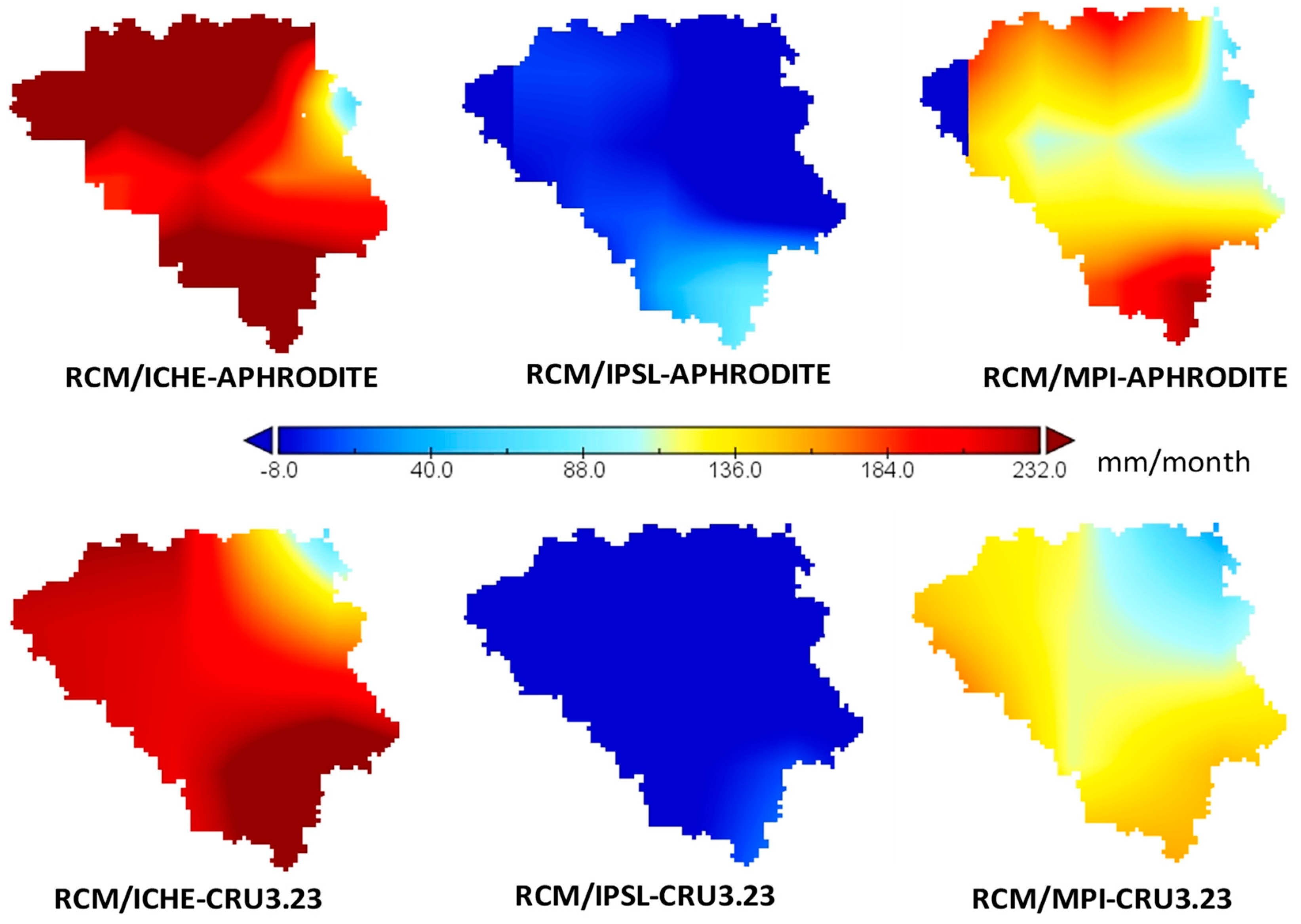
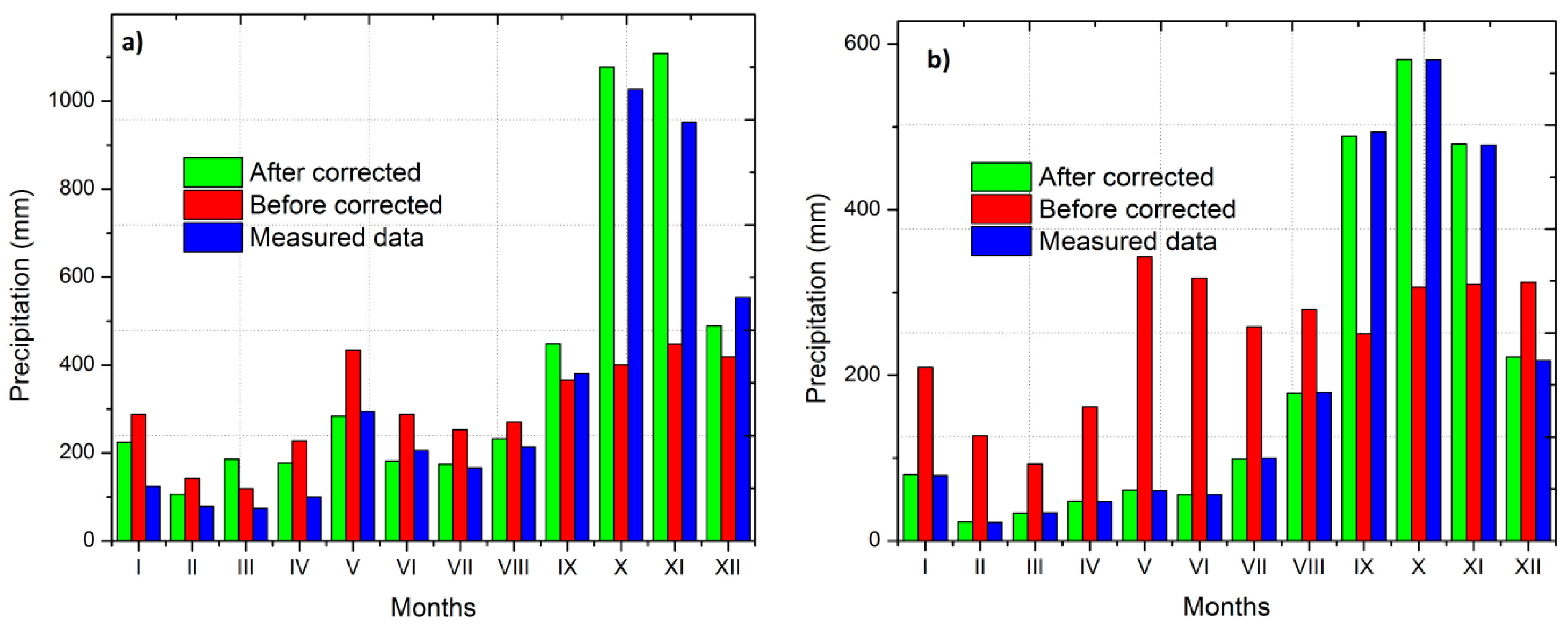
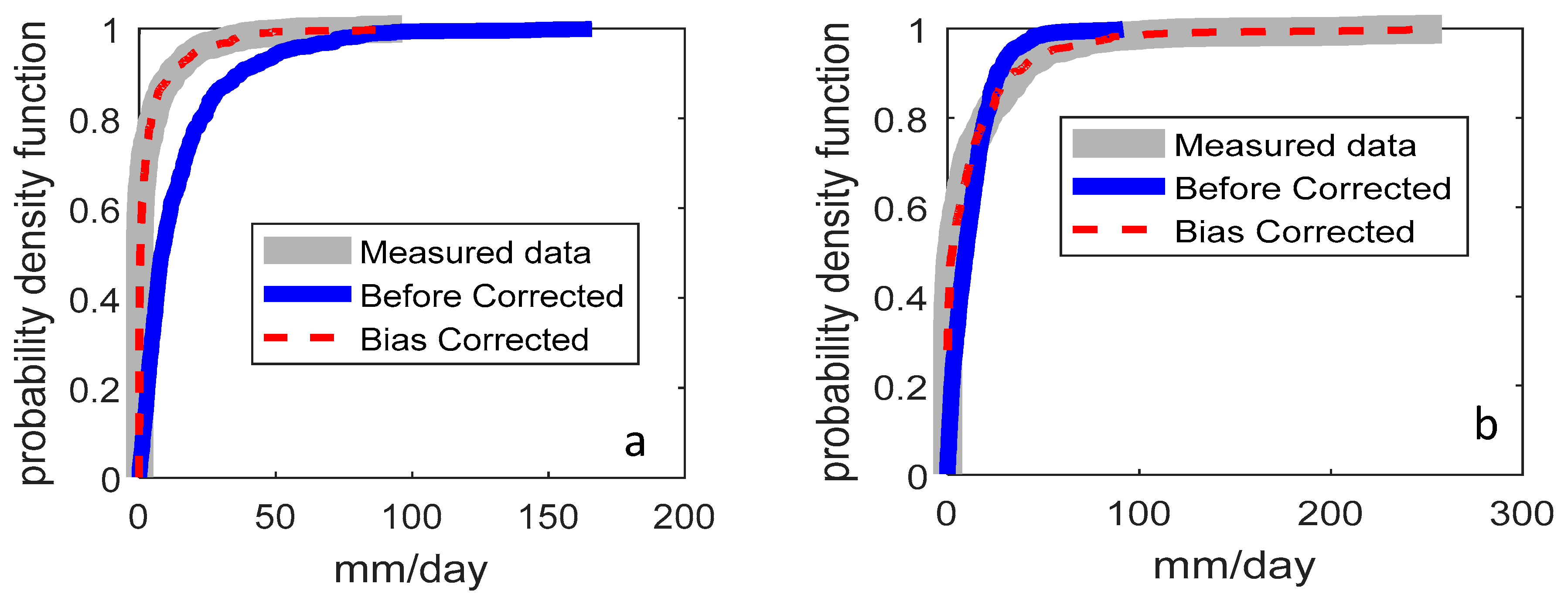
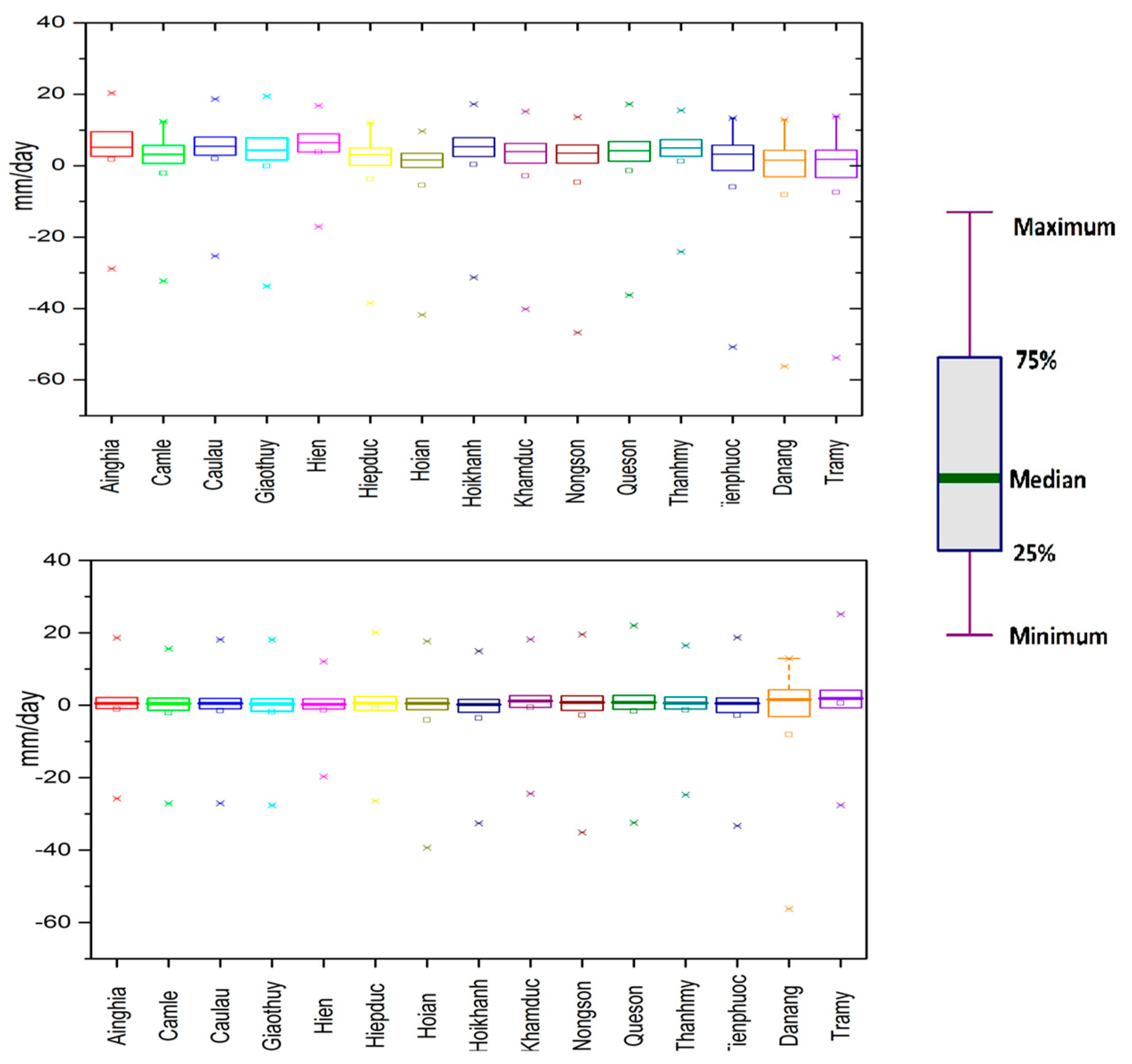
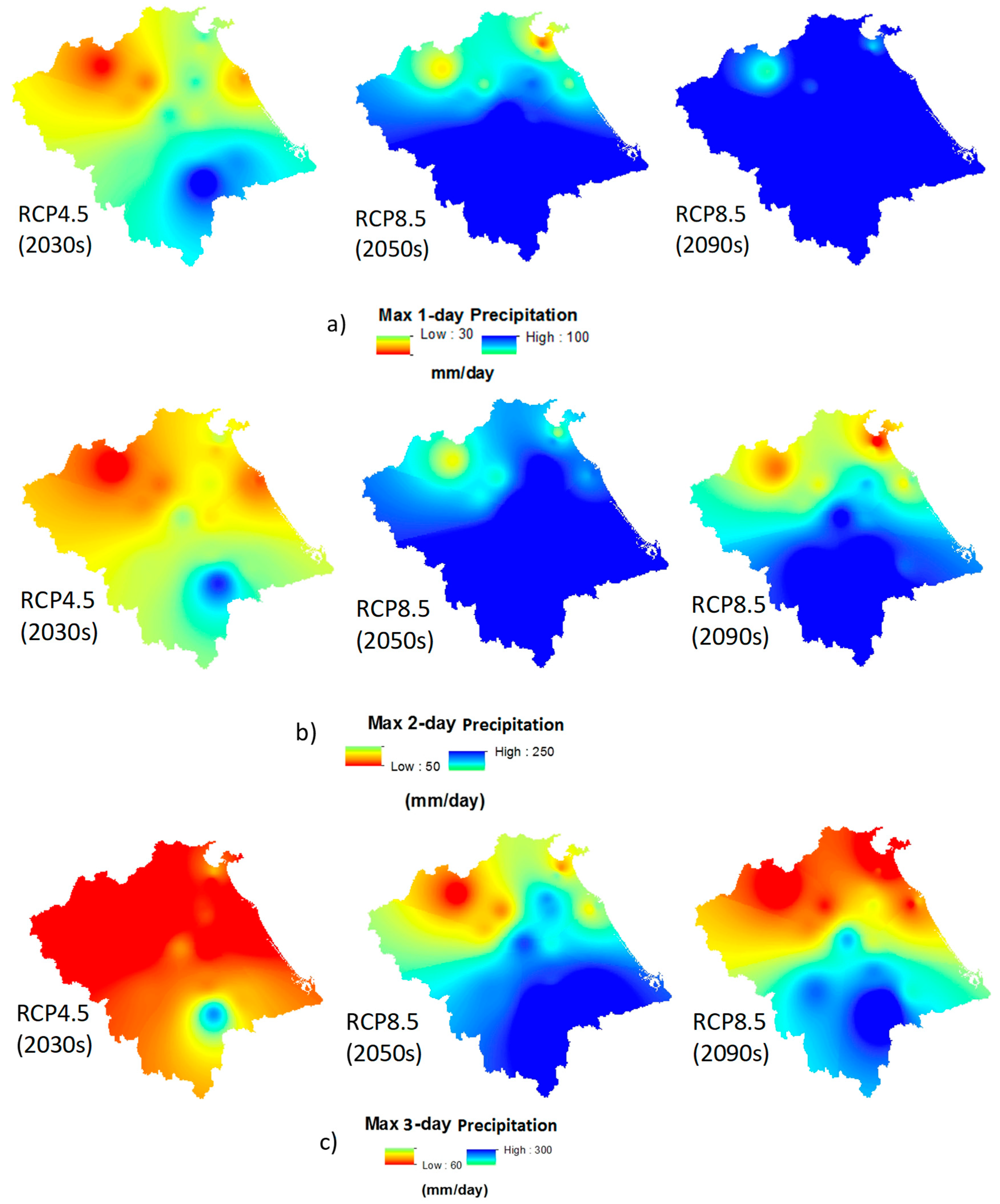
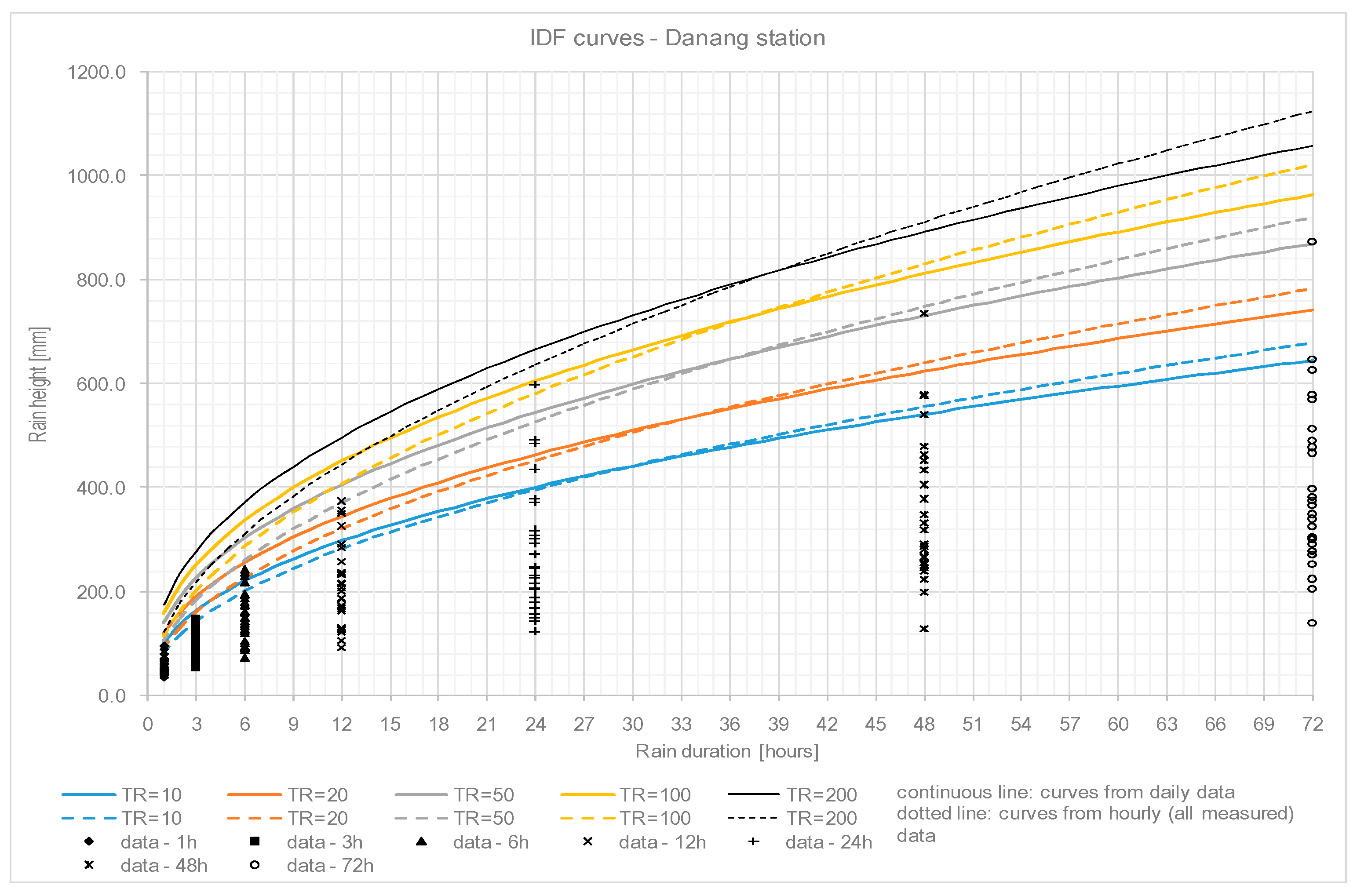
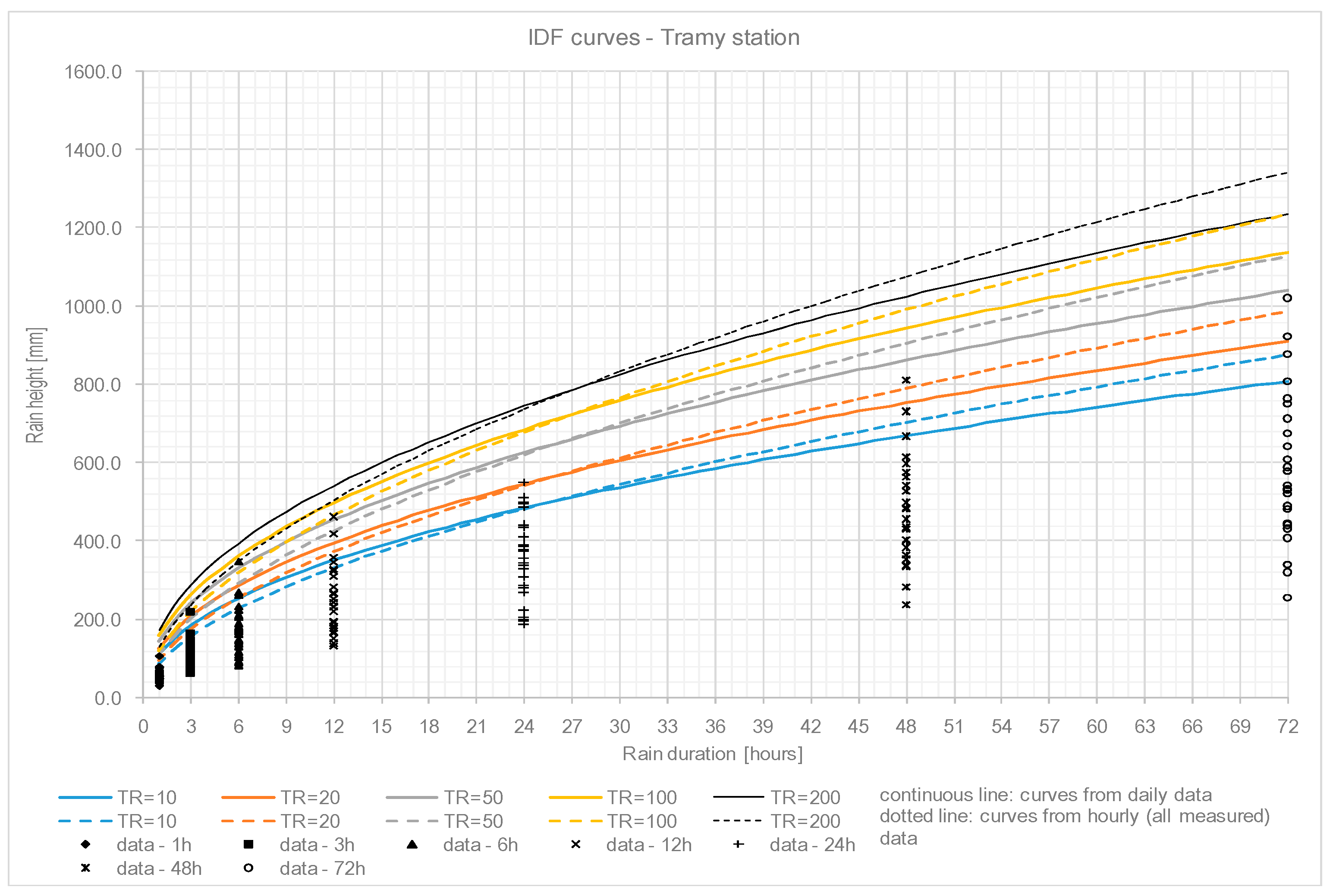
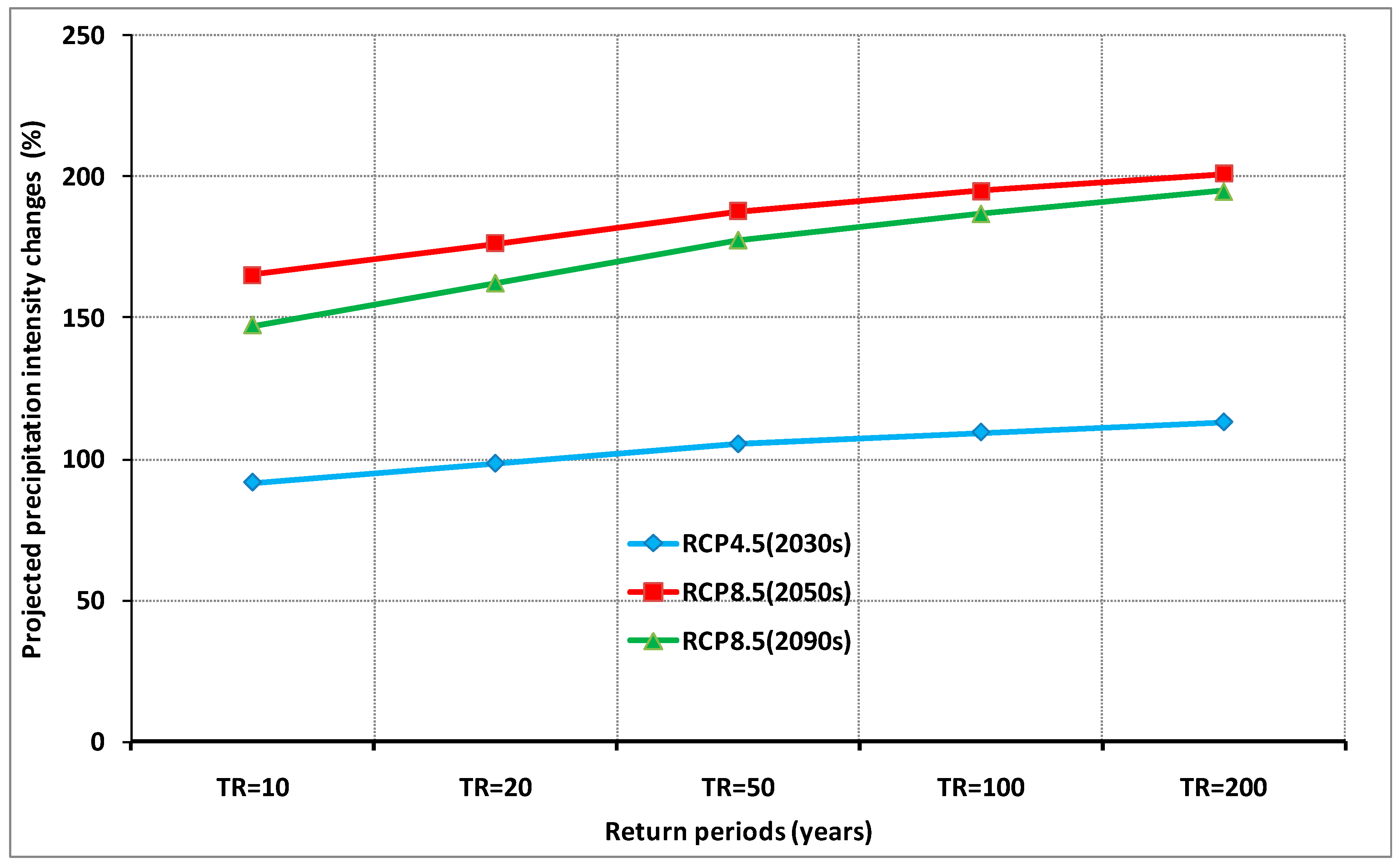
| Historical (1986–2005) | RCP4.5 (2016–2099) | RCP8.5 (2016–2099) | Spatial Resolution | Temporal Resolution | |
|---|---|---|---|---|---|
| RegCM4.3.v4 forced by MPI-ESM-MR (RCM/MPI) | 1 | 1 | 1 | 10 km | 3 h |
| RegCM4.3.v4 forced by IPSL-CM5A-LR (RCM/IPSL) | 1 | 1 | 1 | 10 km | 3 h |
| RegCM4.3.v4 forced by ICHEC-EC-EARTH (RCM/ICHEC) | 1 | 1 | 1 | 10 km | 3 h |
| Duration | 1 h | 3 h | 6 h | 12 h | 24 h | 48 h | 72 h |
|---|---|---|---|---|---|---|---|
| Danang station | 0.756 | 0.768 | 0.881 | 0.990 | 1.084 | 1.063 | 1.034 |
| Tramy station | 0.706 | 0.808 | 0.983 | 1.042 | 1.087 | 1.056 | 1.039 |
| Mean value | 0.731 | 0.788 | 0.932 | 1.016 | 1.086 | 1.059 | 1.037 |
| to be applied to “references” coefficient | to be applied directly on data | ||||||
| Stations | Under RCP4.5 Scenario | Under RCP8.5 Scenario | |
|---|---|---|---|
| 2030s | 2050s | 2090s | |
| Ainghia | 18.8 | 28.7 | 20.8 |
| Camle | 29.3 | 26.5 | 31.6 |
| Caulau | 11.3 | 18.7 | 18.1 |
| Giaothuy | 18.1 | 19.6 | 19.8 |
| Hien | 13.3 | 19.3 | 16.5 |
| Hiepduc | 14.3 | 21.4 | 20.0 |
| Hoian | 19.8 | 26.2 | 23.6 |
| Hoikhanh | 15.3 | 21.9 | 17.7 |
| Khamduc | 11.4 | 17.1 | 18.7 |
| Nongson | 15.8 | 22.5 | 19.1 |
| Queson | 15.9 | 22.0 | 19.3 |
| Thanhmy | 14.3 | 20.2 | 16.9 |
| Tienphuoc | 14.2 | 23.3 | 20.6 |
| Danang | 14.0 | 24.2 | 19.9 |
| Tramy | 16.6 | 27.2 | 26.8 |
| Parameter | a (10 years) | a (20 years) | a (50 years) | a (100 years) | a (200 years) | n (10 years) | n (20 years) | n (50 years) | n (100 years) | n (200 years) |
|---|---|---|---|---|---|---|---|---|---|---|
| Ainghia | 71.78 | 81.83 | 94.84 | 104.59 | 114.30 | 0.53 | 0.54 | 0.54 | 0.54 | 0.54 |
| Camle | 80.51 | 94.55 | 112.75 | 126.39 | 139.98 | 0.50 | 0.49 | 0.49 | 0.49 | 0.49 |
| Caulau | 62.29 | 71.38 | 83.15 | 91.97 | 100.76 | 0.54 | 0.55 | 0.55 | 0.55 | 0.55 |
| Giaothuy | 68.30 | 77.59 | 89.62 | 98.64 | 107.63 | 0.54 | 0.54 | 0.54 | 0.54 | 0.54 |
| Hien | 65.01 | 76.08 | 90.42 | 101.17 | 111.89 | 0.53 | 0.52 | 0.52 | 0.52 | 0.52 |
| Hiepduc | 78.55 | 88.82 | 102.12 | 112.09 | 122.03 | 0.55 | 0.56 | 0.56 | 0.56 | 0.56 |
| Hoian | 73.40 | 86.37 | 103.16 | 115.75 | 128.29 | 0.52 | 0.52 | 0.52 | 0.52 | 0.52 |
| Hoikhanh | 59.93 | 69.00 | 80.74 | 89.54 | 98.30 | 0.55 | 0.55 | 0.56 | 0.56 | 0.56 |
| Khamduc | 72.60 | 82.99 | 96.43 | 106.51 | 116.55 | 0.55 | 0.54 | 0.54 | 0.54 | 0.54 |
| Nongson | 65.20 | 72.21 | 81.30 | 88.12 | 94.92 | 0.55 | 0.56 | 0.56 | 0.56 | 0.57 |
| Queson | 69.19 | 79.13 | 92.00 | 101.64 | 111.25 | 0.53 | 0.53 | 0.53 | 0.53 | 0.53 |
| Thanhmy | 71.78 | 81.83 | 94.84 | 104.59 | 114.30 | 0.53 | 0.54 | 0.54 | 0.54 | 0.54 |
| Tienphuoc | 80.56 | 91.06 | 104.65 | 114.83 | 124.97 | 0.54 | 0.54 | 0.54 | 0.54 | 0.54 |
| Danang | 77.84 | 90.97 | 107.96 | 120.70 | 133.39 | 0.51 | 0.51 | 0.51 | 0.50 | 0.50 |
| Tramy | 81.58 | 92.13 | 105.80 | 116.04 | 126.24 | 0.55 | 0.55 | 0.55 | 0.54 | 0.54 |
© 2018 by the authors. Licensee MDPI, Basel, Switzerland. This article is an open access article distributed under the terms and conditions of the Creative Commons Attribution (CC BY) license (http://creativecommons.org/licenses/by/4.0/).
Share and Cite
Tien Thanh, N.; Dutto Aldo Remo, L. Projected Changes of Precipitation IDF Curves for Short Duration under Climate Change in Central Vietnam. Hydrology 2018, 5, 33. https://doi.org/10.3390/hydrology5030033
Tien Thanh N, Dutto Aldo Remo L. Projected Changes of Precipitation IDF Curves for Short Duration under Climate Change in Central Vietnam. Hydrology. 2018; 5(3):33. https://doi.org/10.3390/hydrology5030033
Chicago/Turabian StyleTien Thanh, Nguyen, and Luca Dutto Aldo Remo. 2018. "Projected Changes of Precipitation IDF Curves for Short Duration under Climate Change in Central Vietnam" Hydrology 5, no. 3: 33. https://doi.org/10.3390/hydrology5030033
APA StyleTien Thanh, N., & Dutto Aldo Remo, L. (2018). Projected Changes of Precipitation IDF Curves for Short Duration under Climate Change in Central Vietnam. Hydrology, 5(3), 33. https://doi.org/10.3390/hydrology5030033




